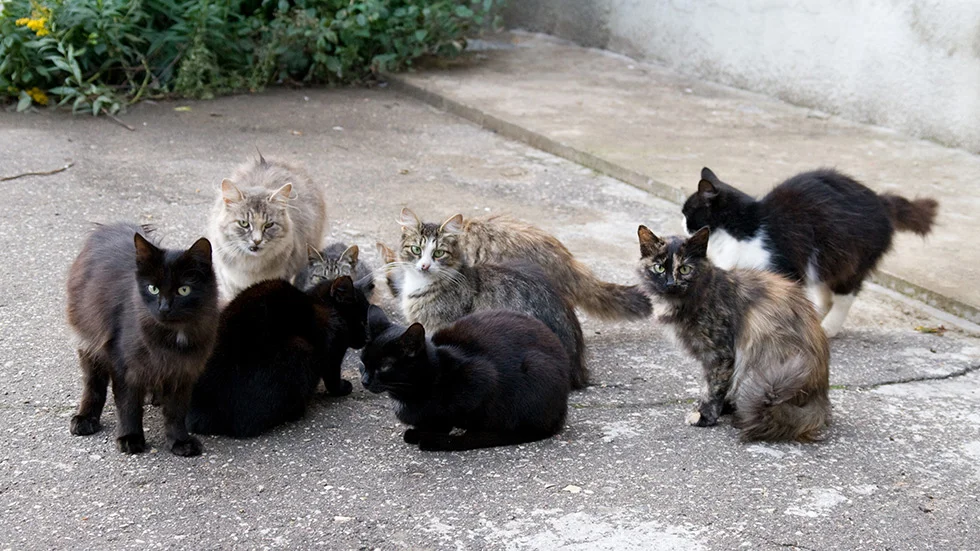在许多摩洛哥社区中,社区猫通常被称为流浪或野猫。这些猫居住在户外,通常不由任何人拥有,但是它们在当地的生态系统中发挥了重要作用。在摩洛哥人道协会中,我们致力于通过人道和有效的解决方案来应对社区猫面临的独特挑战。
我们针对社区猫的举措包括陷阱中的vacinate-Return(TNVR)计划,这些计划有助于控制人群并改善这些猫的健康状况。通过人道地捕捉社区猫,散布或绝育,然后将它们返回其领土,我们减少了街头出生的小猫的数量,并增强了成年猫的整体幸福感。
我们还努力提高人们对社区猫的重要性的认识,并促进使猫和所居住的社区受益的共存策略。通过教育和协作,我们旨在为摩洛哥各地的社区猫创造一个更安全,更健康的环境。

有时,当我们在社区中看到猫时,我们可能会认为他们需要我们的帮助。这里有一些有关您在摩洛哥遇到社区猫时应该做什么的技巧
什么是社区猫?
社区猫是我们在社区中看到的猫科动物。这些猫来自各种背景。一些社区猫是野性的。一些社区猫以前是拥有和废弃的。其他社区猫是所有的,但在他们家附近。
社区猫有很多名字:邻里猫,流浪猫,漫游猫等。本质上,您外面遇到的每只猫都是社区猫。
我该如何帮助社区猫?
当您在社区中看到猫时,您必须提出的第一个问题是:猫健康吗? 如果猫看起来健康且没有受伤,那么您可以做的最好的事情就是让它们独自一人。最好让猫独自一人,因为:
我看到的猫看起来没有受伤和/或不健康。我应该怎么办?
如果猫看起来很健康且没有受伤,那么最好的办法就是让猫独自一人。
如果猫需要医疗援助,请致电兽医。
当社区猫进入我的院子时,我不喜欢。我该怎么做才能阻止他们?
重要的是要记住,从您所在地区取出猫不会减少猫的数量。如果附近有食物或水源,将会更多的猫进入该地区。
但是,有很多人道的方法可以阻止社区猫进入您的院子。社区猫可能会使用您的空间,因为它提供了食物或庇护所的来源。去除食物来源并阻止进入藏身之处的地方可以阻止社区猫。您也可以:
有关更多信息,请访问我们的页面: 阻止漫游猫。
我不介意在院子里有社区猫。我该怎么做才能帮助他们?
一些市议会,慈善机构甚至邻居在非居民区域为猫提供陷阱,中性和返回计划。它旨在改善社区猫的生活并减少其数量。非居民区的猫被像您这样的人所困,带到兽医进行阶段/中性手术,接种疫苗,然后释放回他们的社区。
在摩洛哥的某些地区,我们经历了极端天气 - 既热又寒冷。在寒冷的天气和炎热的天气下找到照顾社区猫的技巧。
| 曲奇饼 | 期间 | 描述 |
|---|---|---|
| cookielawinfo-复选框分析 | 11个月 | This cookie is set by GDPR Cookie Consent plugin. The cookie is used to store the user consent for the cookies in the category "Analytics". |
| cookielawinfo-复选框功能 | 11个月 | The cookie is set by GDPR cookie consent to record the user consent for the cookies in the category "Functional". |
| cookielawinfo-复选框-必要 | 11个月 | This cookie is set by GDPR Cookie Consent plugin. The cookies is used to store the user consent for the cookies in the category "Necessary". |
| cookielawinfo-复选框-其他 | 11个月 | This cookie is set by GDPR Cookie Consent plugin. The cookie is used to store the user consent for the cookies in the category "Other. |
| cookielawinfo-复选框性能 | 11个月 | This cookie is set by GDPR Cookie Consent plugin. The cookie is used to store the user consent for the cookies in the category "Performance". |
| 查看的_cookie_政策 | 11个月 | 该cookie由GDPR Cookie Consent插件设置,用于存储用户是否同意使用cookie。它不存储任何个人数据。 |
在继续您的收养申请之前,请查看并接受我们的数据处理惯例:
笔记: By clicking "I Agree & Continue", you will be redirected to an external application form. This tracking system logs your interest but does not capture data from the external form.
在继续您的收养申请之前,请查看并接受我们的数据处理惯例:
笔记: By clicking "I Agree & Continue", you will be redirected to an external application form. This tracking system logs your interest but does not capture data from the external form.